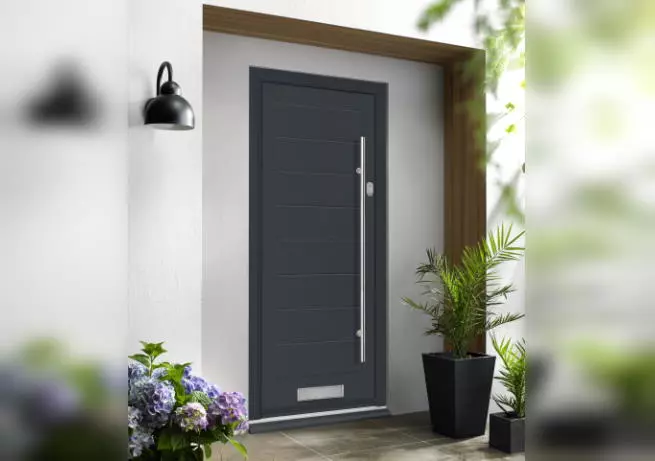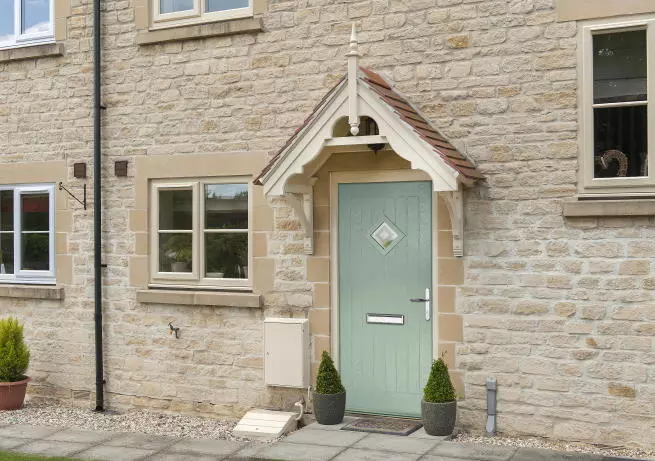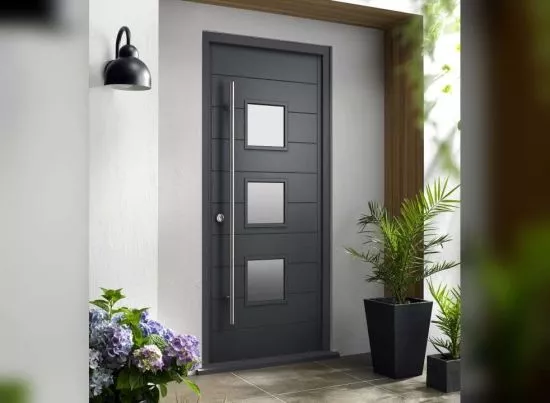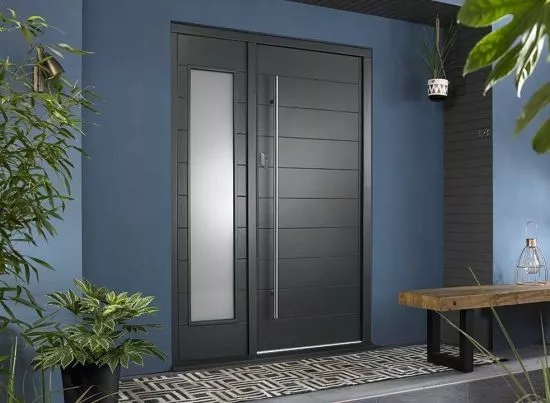UNDERSTANDING STANDARD FRONT DOOR SIZES | HOW TO CHOOSE THE BEST DOOR SIZE & MATERIAL
Replacing the front door or any entry door in your home can be difficult, particularly if you’re unsure about standard UK door measurements. The United Kingdom is home to a variety of different property types, from rural country cottages to urban, multi-storey apartment blocks. However, most properties tend to correspond with a standard front door size, so replacing your old front door should be easy – no matter whether you choose a modern front door, or a traditional style.
Here, we take you through standard UK front door sizes, what to consider when choosing a front door size. We also guide you on installing a new front door.
In this guide:
Learn more about what you should think about when choosing the right front door size for your home.
Find out more about what standard front door sizes are in the UK.
Learn more about the factors to consider when choosing the best front door for your home.
Read what factors can impact the cost of installing a new front door.
Read our tips on what to consider when choosing the best material for a new front door.
We answer your questions on understanding front door sizes and materials.
WHAT FRONT DOOR SIZES ARE AVAILABLE?
If your home is one of the majority of properties that feature standard door sizes, the good news is that replacing your front door should be quick and easy, as most suppliers will hold doors to fit your property as a stock item with a quick turnaround time. The opening you have available for your existing door will determine the standard door size or the custom door size you need unless you’re looking to create a new rough opening or widen the opening to install a different style or type of door.
Read our full guide on how to measure doors here.
Of course, there are a number of variables to consider when it comes to your door dimensions; for example, if your property has a double front door and one of them has become damaged, it might be easier to replace both at the same time instead of sourcing a matching door to replace the existing set.
However, as a general rule, most properties feature standard door sizes. Once you’re certain of the size of your door frame, you should be able to find a suitable replacement front door with ease.
You can read our complete guide to front door sizes and options for your home here.
WHAT ARE THE STANDARD UK FRONT DOOR SIZES?
When it comes to replacing a glazed external door, one of the most commonly asked questions is “what is the standard front door size in the UK?”. The answer to this question is that there are several different standard sizes, although most properties adhere to one of these. The following are considered standard door width sizes within the UK:
-
711.2mm or 28”
-
762mm or 30”
-
812.8mm or 32”
-
838mm or 33”
-
914.4mm or 36”.
By far the most popular standard door widths in the UK are 762mm (or 30 inches) and 838mm (33 inches). A door width measuring 838mm are more commonly used in modern buildings, as they comply with regulations for disability access.
Shop our full range of front doors here to view our selection of door widths and sizes.
ARE YOU LOOKING FOR A DURABLE, TRADITIONAL COMPOSITE FRONT DOOR?
Our pick:
Vufold traditional composite front doors
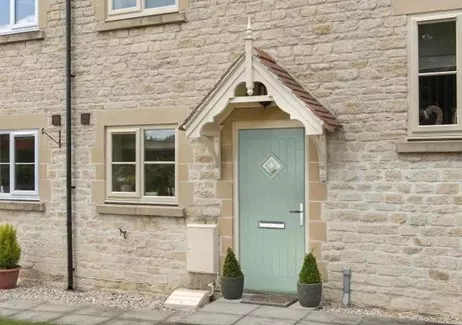
Offering style, security and great value, our signature aluminium front doors are designed for the modern family. Virtually maintenance free, thermally efficient, and available in a range of styles and designs to suit any home.
Shop our Signature aluminium front door range.
- Thermally Efficient - U Value of 1.4 W/m2K (Energy Rating B)
- Safe and Secure - PAS 24 in line with Document Q tested
- Easy Install - full fitting kit included
- Guarantee - 10 Years.
Shop our range of traditional composite entrance doors today.
Shop our full range of front doors here to view our selection of door widths and sizes.
WHAT ARE NON-STANDARD UK FRONT DOOR SIZES?
It is a common misconception that some properties have been built to “non-standard” door sizes. In many cases, homeowners will try to cut a standard door down to an appropriate size or place several millimetres off the edges. This is not the most effective solution as it exposes the core of the door and could potentially weaken it, affecting security.
While the width of your doors might not adhere to the two most common sizes (762mm and 838mm), it is likely that you will still be able to find a product that has been purpose-built for your door frame size.
It is worth pointing out that most doors on the market have a 6mm edge which can be trimmed for a perfect fit, but any further cutting should be avoided as this could damage the door. Instead, you should consult with a professional to find a suitable door for your property.
OTHER FACTORS TO CONSIDER WHEN CHOOSING THE BEST SIZE FOR YOUR FRONT DOOR
DOOR THICKNESS
An external door should be between 40-45mm thick. Ideally, the thicker the door, the better. A thicker exterior door will provide better protection from the elements and could potentially provide better insurance against potential intruders. If you live in a property with shared access, there may be certain stipulations as to how thick your front door needs to be for health and safety purposes.
Are you choosing the ideal front door for your home? Find out more about front door size options here.
BUILDING REGULATIONS
Since 2002, building regulations have applied to controlled fittings. Both internal and exterior doors fall under this category, which means certain standards need to be met when they are replaced.
IS YOUR FRONT DOOR BESPOKE?
Vufold understands that first impressions count and offers a huge variety of front door materials to suit all property types and sizes. From composite and aluminium to natural oak, there’s something for everyone. Prices start at just £519, with the following standard sizes available:
-
1981mm x 762mm
-
1981mm x 838mm
-
2032mm x 812mm.
Are you choosing a new front door? Read our guide to the different front door accessories here.
Visit our product reviews page to find out more about the benefits of choosing Vufold for your front door or patio door.
INSTALLING A NEW FRONT DOOR
HOW MUCH DOES IT COST TO INSTALL A FRONT DOOR?
When it comes to installing your new front door, you should also consider the cost of installation alongside the cost of the door by itself.
-
Does the old door need to be removed professionally?
-
Are you replacing the door frame too?
-
Is any customisation required (such as the frame needing to be re-sized)?
-
Do letterboxes, an additional lock, door knockers or handles need to be installed?
When installing your front door, you should also consider the additional aspects that will likely add to the costs. These include:
Extra finishes – Door finishes include factors such as whether you want a timber door to be painted or stained to give it a more premium finish.
ARE YOU LOOKING FOR A DURABLE FRONT DOOR WITH A NATURAL OAK FINISH?
Our pick:
Vufold’s Oslo External Oak Front Door
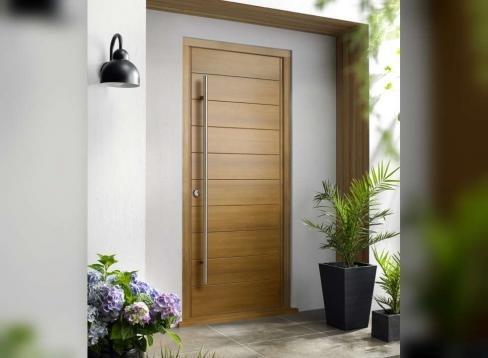
- Fully finished with a high quality wood coating system
- Uses our patented high performance CLPF core
- Installation touch-up kit included so that trimmed doors can be refinished before final fitting
- Full range of accessories available to complete the look
- 10 Year Guarantee.
Door accessories – Your front door has many purposes. As well as being the main physical entrance to your house, you will need to think about what features you would like to be added to it to make it more useful. Read our guide to choosing external front door accessories here.
Custom-made doors – a custom made door is totally unique to you and your specification. As it is made to your own unique requirement, it can be slightly more expensive.
Shop our selection of bespoke front doors here.
WHAT FRONT DOOR MATERIALS ARE AVAILABLE FOR A NEW FRONT DOOR?
Solid wood, uPVC, aluminium, and composite are some popular materials used for front doors. As opposed to choosing an interior door – choosing a new front door requires putting more thought into thermal efficiency and durability. Read more about front door materials here.
Here at Vufold, our Ultimate external wooden front doors have a cross-laminated hardwood foam (CLPF) core which offers excellent insulation and strength. This is covered with a five-layer cross-grained hardwood sheet for ultimate durability, and a hardwood veneer that is factory-finished with a microporous coating to provide excellent weather protection.
uPVC doors are affordable and low maintenance, but they are not as durable as other materials that may provide a more stable door option.
A composite door is made up of layers of different types of material that offers the ultimate in strength, durability, and thermal efficiency. You can view our range of composite front doors here. Learn more about choosing between timber doors or composite front doors.
Aluminium front doors provide a sleek, modern style, and are known for their exceptional strength and durability. Because of this, they are often slightly more expensive than other materials. However, they make an excellent long-term investment, and an aluminium front door is often highly sought after when finding a property. Read our guide to choosing modern aluminium front doors here.
Expert Quote:
"Aluminium as a material will comfortably outlast uPVC, which has a lifespan of only 20 to 30 years”.
- Rick Collins, Director, Vufold
Vufold’s Signature Front Door range
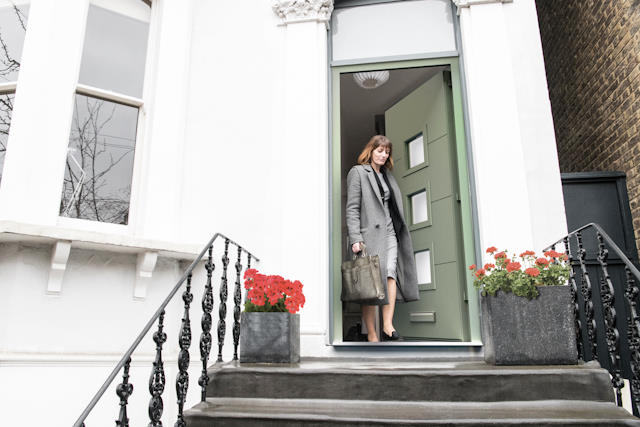
Offering style, security and great value, our signature aluminium front doors are designed for the modern family. Virtually maintenance free, thermally efficient, and available in a range of styles and designs to suit any home.
If you’d like to know more about the sizes we have on offer at Vufold or bespoke front doors, please contact our team of experts today.
FREQUENTLY ASKED QUESTIONS
CAN YOU REPLACE THE GLASS IN FRONT DOORS?
It is possible to replace a glass panel in a front door. However, in order to maintain the thermal efficiency, strength and security of the original door, you should aim to replace the glazing like-for-like with that of the original, or better.
CAN A FRONT DOOR OPEN OUTWARDS?
Most front doors open inwards. There are several reasons for this. Firstly, it means that the hinge mechanism is located on the inside of the property to make the door more secure. Secondly, it prevents the door from being caught in the wind when opened and potentially causing damage. Thirdly, it is simply easier to answer the door to visitors without the risk of bumping into them with the door.
It is possible to fit an outward opening entrance door if you prefer. If you are purchasing an Ultimate front door to fit into an existing frame, it can be fitted to open inward or outward. However, when you buy an Ultimate front door with our frame kit, the door can only be fitted to open inwards.
HOW WIDE SHOULD MY FRONT DOOR BE?
There is no standardised external door size in the UK. However, the most common door size is 762mm wide and 1981mm high. When measuring for a new front door, keep in mind that the actual size of the aperture will be a little larger than the size of the door itself to account for the door frame.

About John Collins
John has built Vufold into a unique online door and window company and has spent 20 years bringing innovative products and designs to fruition, recognising niches in the market and placing them in the likes of Wickes and Travis Perkins, he started Vufold in order to sell them directly. John founded Vufold and has amassed a wealth of experience in product design and development, and in particular timber-based products
Read more about John Collins


